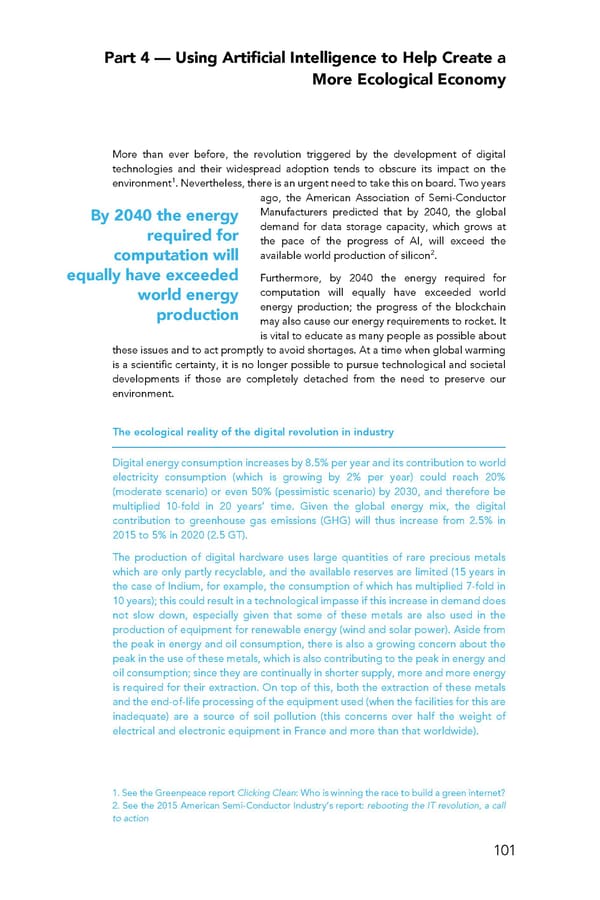Part 4 — Using Artificial Intelligence to Help Create a More Ecological Economy More than ever before, the revolution triggered by the development of digital technologies and their widespread adoption tends to obscure its impact on the environment1. Nevertheless, there is an urgent need to take this on board. Two years ago, the American Association of Semi-Conductor By 2040 the energy Manufacturers predicted that by 2040, the global required for demand for data storage capacity, which grows at the pace of the progress of AI, will exceed the computation will available world production of silicon2. equally have exceeded Furthermore, by 2040 the energy required for world energy computation will equally have exceeded world production energy production; the progress of the blockchain may also cause our energy requirements to rocket. It is vital to educate as many people as possible about these issues and to act promptly to avoid shortages. At a time when global warming is a scientific certainty, it is no longer possible to pursue technological and societal developments if those are completely detached from the need to preserve our environment. The ecological reality of the digital revolution in industry Digital energy consumption increases by 8.5% per year and its contribution to world electricity consumption (which is growing by 2% per year) could reach 20% (moderate scenario) or even 50% (pessimistic scenario) by 2030, and therefore be multiplied 10-fold in 20 years’ time. Given the global energy mix, the digital contribution to greenhouse gas emissions (GHG) will thus increase from 2.5% in 2015 to 5% in 2020 (2.5 GT). The production of digital hardware uses large quantities of rare precious metals which are only partly recyclable, and the available reserves are limited (15 years in the case of Indium, for example, the consumption of which has multiplied 7-fold in 10 years); this could result in a technological impasse if this increase in demand does not slow down, especially given that some of these metals are also used in the production of equipment for renewable energy (wind and solar power). Aside from the peak in energy and oil consumption, there is also a growing concern about the peak in the use of these metals, which is also contributing to the peak in energy and oil consumption; since they are continually in shorter supply, more and more energy is required for their extraction. On top of this, both the extraction of these metals and the end-of-life processing of the equipment used (when the facilities for this are inadequate) are a source of soil pollution (this concerns over half the weight of electrical and electronic equipment in France and more than that worldwide). 1. See the Greenpeace report Clicking Clean: Who is winning the race to build a green internet? 2. See the 2015 American Semi-Conductor Industry’s report: rebooting the IT revolution, a call to action 101
 For a Meaningful AI - Report Page 101 Page 103
For a Meaningful AI - Report Page 101 Page 103